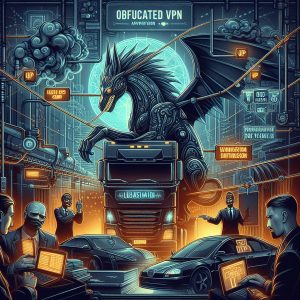Introduction
An obfuscated VPN is a type of virtual private network connection that uses special protocols to disguise VPN traffic as regular HTTPS internet browsing data. This prevents outsiders such as internet service providers (ISPs), government agencies, or streaming platforms from recognizing and blocking VPN connections.
VPNs are often used to bypass geo-restrictions, access censored content, securely connect to public WiFis, and keep browsing activities private. However, many organizations actively try stopping VPN connections which they see as threatening infrastructure or violating terms of service.
Obfuscation solutions hide the fact a VPN tunnel exists altogether. Instead of easily identifiable protocols like OpenVPN or IKEv2 that mark VPN traffic through telltale fingerprints in data packets, obfuscated alternatives appear indistinguishable from any other HTTPS web browsing session.
Let’s explore what specific obfuscation technologies are available, why obfuscation matters for preserving digital privacy, and steps for configuring a VPN connection with obfuscation enabled for max censorship circumvention capability.

Obfuscation Methods
There are a few common methods virtual private network providers use to disguise VPN traffic, each having their own pros and cons:
- Shadowsocks Shadowsocks operates at OSI level 3 (net layer) to encrypt traffic payload, obfuscating contents in a non-descriptive way unidentifiable through superficial packet inspection. However encryption headers may still reveal VPN usage unless additional obfsproxy plugins activated. Open source codebase allows customization.
- Obfsproxy Obfsproxy works in conjunction with more commonly used VPN software suites as a plugin layer to further anonymize network data and defeat common VPN blocking techniques:
- Traffic Flow Obfuscation – Modifies size/timing of packets to avoid set VPN flow patterns
- Cert Fingerprint Obfuscation – Spoofs fake certificate credentials appearing as normal web traffic
- Protocol Obfuscation – Morphs VPN connections to mimic other protocols like HTTP to bypass firewall rules
Obfsproxy proven effective getting past deep packet inspection thanks to these adaptive “traffic shaping” mechanisms. As standalone solution lacks encryption so requires pairing with OpenVPN or other VPN tunnel.
- Stunnel Stunnel encrypts datasessions at the transport layer then uses industry standard Secure Sockets Layer/Transport Layer Security (SSL/TLS) protocols for routing packets. This allows tunneling VPN connections inside an encrypted channel appearing identical to any remote device accessing a SSL protected website. In this sense Stunnel is “piggybacking” VPN on the back of legitimate HTTPS traffic.
- OpenConnect Originally developed by Cisco, OpenConnect defines connections for its own AnyConnect SSL VPN client using standard HTTPS ports and TLS protocols. Thus OpenConnect VPN traffic remains indistinguishable from any benign HTTPS web browsing data.
Open source forks like ocserv now available allowing setup of customize OpenConnect VPNs without Cisco products. However less configurability and features compared to OpenVPN.
As shown above, obfuscated VPN solutions use varied technical approaches. But each abides by the same principles – anonymize data at a packet level while encapsulating transmissions in legitimate seeming protocols like HTTPS. This makes VPN traffic metadata blend into the vast internet noise.
Use Cases
Now that you understand how obfuscated VPN protocols function at a technical level, what are some real-world examples where obfuscation circumvents blocks to access internet content?
Here are the most common use cases:
Bypassing National Firewalls and ISP Throttling
Many authoritarian countries like China, Iran and Russia operate nationwide firewall systems that explicitly block VPN traffic through deep packet inspection. So obfuscation techniques are mandatory for locals needing VPN tunnels providing uncensored internet access.
Obfsproxy setup with the popular OpenVPN protocol succeeds bypassing firewall DPI more readily than using OpenVPN alone which has very distinguishable traffic patterns. Popular VPN provider NordVPN launched obfuscated servers called NordLynx last year using WireGuard and custom masking techniques allowing several thousand users in restrictive countries regain VPN access that had been lost.
Similarly on a smaller scale, some US internet providers throttle detected P2P transfers and video streaming traffic on home networks. Adding an obfsproxy plugin layer tricks ISP throttling by causing VPN connections to bypass traffic detection systems.
Circumventing Streaming Geo-blocks
Streaming platforms vigilant against VPN connections geo-spoofing location to access blacked out content in unauthorized regions frequently block detected VPN traffic. For example Netflix prominently blocks IPs belonging to thousands of static VPN servers.
Obfuscation helps avoid IP ranges known by streaming sites to belong to VPN services. By hiding VPN traffic signature, obfuscated data streams avoid geo-location checks granting much greater success accessing region-exclusive film and tv libraries abroad just like a local viewer located internally. SSH tunneling or OpenVPN over SSL works to unblock Netflix, Hulu, Sky Go and similar video sites with increasing reliability compared to standard VPN approach alone.
Protecting Traffic from Public WiFi Snooping
On unsecured public WiFi networks, user internet traffic faces serious sniffing threats from bad actors who can steal passwords, banking details and other unencrypted data from shared traffic streams.
Accessing any private data over HTTPS websites already provides a baseline level of encryption safe from prying eyes. Adding an extra obfuscated VPN tunnel on top hides the fact VPN encryption is even taking place. This provides an untraceable cloaking mechanism ideal for guarding sensitive mobile traffic and anonymous tracked browsing activity in public places.

Implementation
Now we will outline how to actually setup an obfuscated VPN configuration protecting your internet traffic across devices:
Desktop OS Install
- Establish your base VPN connection using preferred provider software first without obfuscation enabled. Confirm basic feature functionality.
- Install additional plugins like Obfsproxy adding the obfuscation layer integrated natively into your existing VPN client software suite:
Windows – Download and install the Obfsproxy executable then direct OpenVPN client instance to leverage service similar to a proxy obedience setting. Configure cipher mode.
MacOS – Tunnelblick VPN software for OS X has built-in support enabling Obfsproxy support which becomes active when specified server offering obfuscation connected.
Linux – Most distributions include open source Obfsproxy in software repositories or bundled within security focused distros like Tails allowing enabling obfuscated connections in OpenVPN profiles.
- Connect VPN app to obfuscated-enabled server and check for DNS/IP leaks to confirm obfuscation operative without traffic escaping box tunnel to reveal true user identity behind the VPN curtain.
Router-based Configuration
Third party open source router firmware enables configuring an obfuscated VPN tunnel at the device level funnelling all wireless network traffic from connected laptops, phones and smart home equipment through the encrypted exit node:
- Install DDWRT or OpenWRT open source firmware on compatible router replacing stock OS; unlocking more VPN features.
Reset device and access admin panel.
- Navigate VPN menu and input necessary credentials + remote server settings provided by commercial VPN provider with obfuscation capacity such as NordVPN or ExpressVPN. Select protocol supporting obfuscation extensions like OpenVPN. Enable add-ons such as Scramblesuit plugin.
- Save changes and connect router to obfuscated VPN remote server through new VPN interface. Confirm connection successful and all home devices now have internet traffic passing only through active obfuscated tunnel.
Using reputable VPN provider infrastructure and the steps above correctly integrate OpenVPN obfuscation plugins fortifies VPN protection from common blocking and throttling measures. However no method promises guaranteed, perpetual access. Ongoing upkeep is required as access restrictions and counter technologies evolve on all sides.
Challenges and Solutions
While obfuscated VPN protocols foil many basic network filtering techniques, increasingly sophisticated AI-supported mechanisms deployed by streaming giants and iron-fisted regimes continually threaten to undermine VPN traffic slipping past gates.
Let’s examine some real world examples of obfuscated VPN blocking scenarios and ways administrators work rapidly to Nullify restrictions while users take proactive measures preserving their digital liberties.
Russia Blacklists “Anonymous” Traffic Including VPNs
In 2021 Russian internet regulations mandated that all internet traffic flow through government-controlled routing gateways enabling analysis and filtering protocols deemed dangers to state security – namely obfuscated VPN connections granting uncensored web access. Deep packet inspection specifically keyed into data flows attempting obfuscation at the transport layer like OpenVPN over SSL/TLS.
While traditional VPN connections found almost all IP addresses blocked entirely, providers quickly shifted affected Russian customers to alternative obfuscated protocols called VLESS that further anonymized data and bypassed fresh DPI countermeasures for months subsequent until VLESS IPs ultimately landed on Russia’s expanding blacklist in late 2022.
This ongoing “cat and mouse” game shows the indispensability of VPN obfuscationcapabilities giving anti-censorship developers precious extra response time devising updated tunneling techniques that preserve open information access within oppressive regime strongholds. Having easily disabled obfuscation layers baked into VPN apps also allows nimble server-side upgrades keeping countries ounces ahead of pursuing technological suppression.

Conclusion
This guide covered the critical role obfuscated VPN connections fill reaching internet destinations made unreachable through mainstream VPN protocols alone when faced with advanced firewall AI actively working to sever access.
We decrypted how running VPN traffic through additional obfuscation transports like Shadowsocks, obfsproxy plugins, or common remote access protocols disguise data signatures. This in turn allows VPN packets slip past strict censorship technology undetected at growing rates to bypass geo-restrictions stopping locked streaming content plus provide citizens under authoritarian domes lifeline contact with outside world.
As national firewalls and ISP throttling technologies progress, the need for optimizing VPN resilience through multilayered obfuscation techniques intensifies. Supporting providers advancing stealth innovation helps ensure the VPN community and user rights advocates maintain the upper hand securing digital liberties for all still under threat from institutional suppression worldwide.
Though vpn-blocking restrictions will certainly continue evolving, dedication from VPN services making privacy protection and obfuscation central to their infrastructure design philosophy will provide the tools enabling more users tap liberty beyond borders.